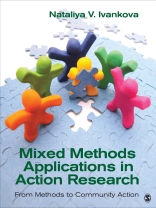This first-of-its-kind book provides readers with the information they need to design and conduct a mixed methods action research (MMAR) study in a practical and pragmatic manner. Using a multidisciplinary focus, the author provides a scholarly and applied orientation to meet the varied epistemological and professional needs of scholar practitioners. The book is applicable to broad audiences with different levels of research skills, including students learning how to conduct research in practical settings, practitioners faced with the need to address pertinent issues in their professional practices, community leaders seeking to inform policy changes, and college faculty who teach research methods and conduct funded research in collaboration with practitioner-researchers and community stakeholders. A wide variety of pedagogical features make it appropriate for use as an instructional text aimed at developing skills in designing, conducting, implementing, and reporting an action research study that integrates mixed methods.
表中的内容
Part I: Applying Mixed Methods in Action Research
Chapter 1: Introducing Mixed Methods Research
Definitions of Mixed Methods Research
Example of a Mixed Methods Research Study
Rationales for Using Mixed Methods Research
Evolution of Mixed Methods Research
Current Status of Mixed Methods Research
Philosophical Foundation of Mixed Methods Research
Methodological Characteristics of Mixed Methods Research
Chapter 2: Introducing Action Research
Definitions of Action Research
Essentials Features of Action Research
Example of an Action Research Study
Conceptual Models of Action Research
Methodological Characteristics of Action Research
Chapter 3: Applying Mixed Methods in Action Research
Connecting Mixed Methods and Action Research
Advantages of Applying Mixed Methods in Action Research
Application of Mixed Methods in Action Research
Examples of Five MMAR Studies
Part II: Designing and Conducting a Mixed Methods Action Research Study
Chapter 4: Conceptualizing a Mixed Methods Action Research Study
Steps in an MMAR Study
Conceptualizing an MMAR Study
Chapter 5: Designing a Mixed Methods Action Research Study
Current Mixed Methods Design Typologies
Typology of MMAR Study Designs
Basic MMAR Study Designs
Chapter 6: Planning Integration of Quantitative and Qualitative Methods in a Mixed Methods Action Research Study
Integration or Mixing of Quantitative and Qualitative Methods
Integrating Quantitative and Qualitative MMAR Study Designs
Developing Study Purpose and Research Questions for Reconnaissance and Evaluation Phases of an MMAR Study
Visual Presentation of MMAR Study Procedures
Examples of Visual Diagrams in MMAR Study Designs
Chapter 7: Sampling and Collecting Data in a Mixed Methods Action Research Study
Sampling in an MMAR Study
Sampling Schemes for MMAR Study Designs
Data Collection in an MMAR Study
Chapter 8: Analyzing Data in a Mixed Methods Action Research Study
Analyzing Quantitative Data in an MMAR Study
Analyzing Qualitative Data in an MMAR Study
Mixed Methods Data Analysis in an MMAR Study
Chapter 9: Assessing Quality of a Mixed Methods Action Research Study
Assessing Reliability and Validity of Quantitative Data and Their Interpretation in an MMAR Study
Assessing Trustworthiness of Qualitative Data and Their Interpretation in an MMAR Study
Addressing Quality Considerations Related to Action Research
Assessing Quality in an MMAR Study
Part III: Using Mixed Methods Inferences to Inform Community Action
Chapter 10: Planning and Implementing Action Using Mixed Methods Action Research Study Inferences
Using Meta-Inferences to Inform Action/Intervention in an MMAR Study
Developing and Implementing Action/Intervention in an MMAR Study
Evaluating and Monitoring Action/Intervention in an MMAR Study
Disseminating MMAR Study Results
Developing a Proposal for an MMAR Study
关于作者
Nataliya Ivankova, Ph D, MPH, is professor in the Department of Health Services Administration with a dual appointment in the School of Nursing at the University of Alabama at Birmingham. She is an applied methodologist working at the intersection of mixed methods, qualitative, community-based, and translational research. She has developed a methodological framework for a sequential quantitative to qualitative mixed methods design that was used in this study. She teaches courses in mixed methods and qualitative research, mentors doctoral students and junior faculty, and serves as a lead methodologist on funded projects. She also directs a graduate certificate program in Applications of Mixed Methods Research. She is a founding co-editor of the Mixed Methods Research Series with SAGE Publishing and is an associate editor for the Journal of Mixed Methods Research and a qualitative research editor for the American Journal of Health Behavior.












